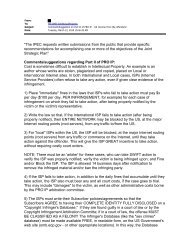We Energies Coal Combustion Products ... - The White House
We Energies Coal Combustion Products ... - The White House
We Energies Coal Combustion Products ... - The White House
You also want an ePaper? Increase the reach of your titles
YUMPU automatically turns print PDFs into web optimized ePapers that Google loves.
Fly ash added in concrete as a supplementary cementing material achieves one<br />
or more of the following benefits:<br />
• Reduces the cement content.<br />
• Reduces heat of hydration.<br />
• Improves workability of concrete.<br />
• Attains higher levels of strength in concrete especially in the long term.<br />
• Improves durability of concrete.<br />
• Increases the “green” recycled material content of concrete.<br />
• Attains a higher density.<br />
• Lowers porosity and permeability.<br />
<strong>The</strong> properties of fly ash, whether ASTM C618, Class C or Class F, and the<br />
percentages in which they are used greatly affect the properties of concrete.<br />
Mixture proportioning and trial batches are critical to obtaining concrete with<br />
the desired fresh and hardened properties. Fly ash may be introduced in<br />
concrete as a blended cement containing fly ash or introduced as a separate<br />
component at the mixing stage.<br />
Most of the <strong>We</strong> <strong>Energies</strong> fly ash is being used in concrete as a separate<br />
component at the concrete batching and mixing stage. This allows the<br />
flexibility of tailoring mixture proportions to obtain the required concrete<br />
properties for the particular application. Ready-mixed concrete producers<br />
have greater control with respect to the class and amount of fly ash in the<br />
concrete mixture to meet the specified performance requirements.<br />
Fly ash has several other properties, in addition to its cementitious and<br />
pozzolanic properties, that are beneficial to the concrete industry (19). Lowcalcium<br />
fly ash (ASTM C618 Class F) has been used as a replacement for<br />
Portland cement in concrete used for the construction of mass gravity dams.<br />
<strong>The</strong> primary reason for this application has been the reduced heat of hydration<br />
of Class F fly ash concrete compared to Portland cement concrete. ASTM<br />
C618 Class C fly ash concrete may also have a slightly lower heat of<br />
hydration when compared to Portland cement concrete. However, low calcium<br />
Class F fly ash concrete generates still lower heat of hydration, a desirable<br />
property in massive concrete construction, such as dams and large<br />
foundations.<br />
Studies have also revealed that certain pozzolans increase the life expectancy<br />
of concrete structures. Dunstan reported that as the calcium oxide content of<br />
ash increases above a lower limit of 5% or as the ferric oxide content<br />
decreases, sulfate resistance decreases (20).<br />
Dunstan proposed the use of a resistance factor (R), calculated as follows:<br />
R = (C-5)/F<br />
Where C = percentage of CaO<br />
Where F = percentage of Fe 2 O 3<br />
<strong>We</strong> <strong>Energies</strong> 50<br />
<strong>Coal</strong> <strong>Combustion</strong> <strong>Products</strong><br />
Utilization Handbook



